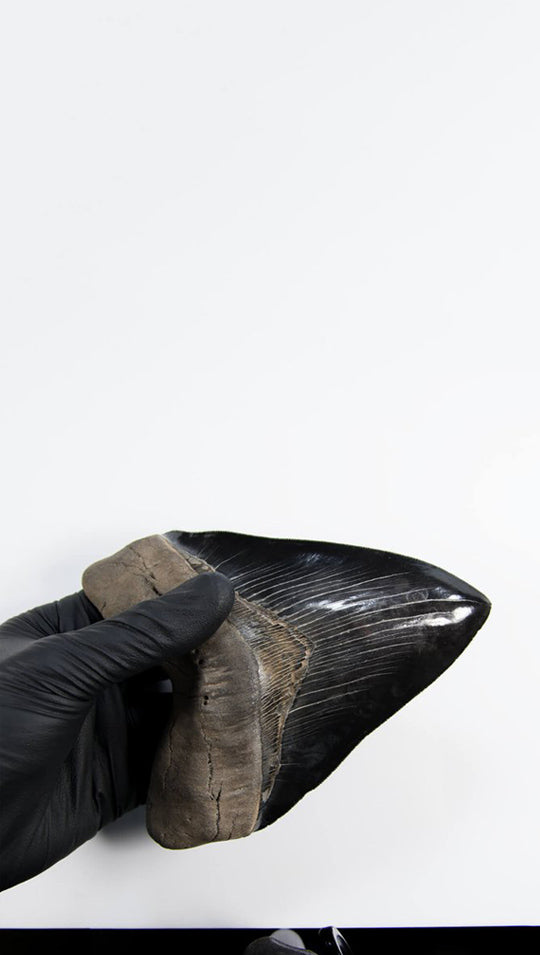Discover The Megalodon
FOSSIL MEGALODON SHARK TEETH UNEARTHED This is my element, seawater water courses over my interlocking dermal scales forcing the currents to streamline my bulk, I circumnavigate the deep and delve...
FOSSIL MEGALODON SHARK TEETH UNEARTHED This is my element, seawater water courses over my interlocking dermal scales forcing the currents to streamline my bulk, I circumnavigate the deep and delve...

This is my element, seawater water courses over my interlocking dermal scales forcing the currents to streamline my bulk, I circumnavigate the deep and delve into the unknown for my prey, this is my domain and my world has no limits, my mass is sixteen meters and fifty tonnes, I am the intimidating predator, I am evolution, I am shark.
Megalodon the terrible leviathan predator of the Cenozoic oceans may have been edged closer to extinction by one of the most docile mammals on the planet. Recently published research reveals conclusive evidence of the feeding habits of Megalodon. Alberto Collareta, of the University of Pisa, explains in the New Scientist magazine, that in his paper published in the journal of Palaeogeography,
Palaeoclimatology and Palaeoecology. For the first time, science can establish what was probably the primary prey mammal of the Megalodon shark. The extinct, 50 tonnes and 60-foot long prehistoric Megamouth shark with 10-foot wide gaping jaws, the whale killer of the Oligocene and Pliocene epoch’s (28 m.y.a - 2.6 m.y.a.), having had a run of top predator for over 25 million years before itself becoming extinct.
Megalodon a warm water predator of the Oligocene to early Pleistocene. Prevalent in the waters which are today North America, an area around the southern waters off the coasts of Florida and the Carolinas, where Megalodon fed on early pygmy type Baleen whales, Priscbalaena nana and large seals Priscophoca Pacifica. Both mammals around 5 metres long (around one-third of Megalodon’s length), these were the perfect bite-size prey for the Mega-mouthed shark. And coincidentally, about the size of a modern-day humpback whale calf (at an average 4 metres), a calf captured on film recently was attacked and killed by a school of dusky sharks [Carcharhinus obscures 2-3 metres long] off the coast of South Africa. Is such behaviour a genetic lineage from ancient ancestors to extant modern-day sharks?
Pygmy baleen whales and large seals developed in warm shallow waters and so to did Megalodon, growing to enormous sizes on its ever-increasing food supply. With prolific serrated edged teeth up to 7.25 inches in size (A modern-day mature adult Gt.White shark of around 20-25 foot, has teeth in size range from 2 inches to 2.5 inches). Holding a large fossil Megalodon tooth in one's hands is the only real way to gauge the terror of Megalodon of the Cenozoic. With a battery of up to 250 razor-sharp triangular teeth in jaws big enough to swallow a small car.
alongside Megalodon larger whales also developed in deeper water. Megalodon bite marks discovered in large whale vertebra and bones led for some time large sperm whales were Megalodon’s main prey source. However, it is not yet clear whether this could have been due to scavenging large post-mortem carcasses. In fact, these large whales may well be a significant key to Megalodon’s extinction. Too big to successfully hunt when the smaller baleen whales became extinct Megalodon suffered a decline. The Cetaceans rapid development also coincided with climate change.
As the poles of the globe became cooler trapping significant quantities of ice, seawater levels dropped globally affecting coastal regions, like the shallow sea ecosystems of the pygmy baleen whales and seals. Baleen whales trended into decline. The remaining baleen whales probably hunted into decline and extinction meant the Megalodon also declined. Food habitats changed, seasonal increases around the poles, the of production of vast quantities of food resulted in significant whale migrations, as whales were better equipped to survive in the much colder food-rich waters, not Megalodon, which favoured warmer waters.
Modern shark studies have shown when large sharks move out of an area or decline in number smaller sharks begin to thrive. Catalina Piemiento of the University of Zurich, in a 6-year long study points towards the decrease in Megalodon coinciding with the development of large whales and also an increase in smaller sharks, however, she claims further work is needed to establish her findings fully. Could this competition have added considerable pressure to the Megalodon plight?
With baleen whales in decline and while seals more easily changed their feeding habits in colder climates or were hunted out by smaller sharks, Megalodon ultimately suffered and continued on a steady decline. Baleens became extinct around 3 million years ago, 400,000 years later (2.6 m.y.a.), Megalodon followed the small whales into extinction. Other sharks took the place of Megalodon. A lot more research will be needed and fossils to be yet discovered, with more intriguing feeding marks, before science can establish the whole Megalodon and Cenozoic marine scene story, this is a work in progress.





Your BAG is empty
Go Explore
